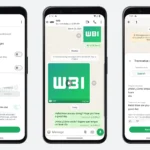
Starting this week, the Google Translate app will be capable of visually translating 13 new languages by using the camera on your smartphone.
In 2015, Google added the visual translation feature to the Translate app with the support of 27 different languages. It allows users to translate dinner menus and signs in real time, making communicating abroad much easier. This week’s announcement adds Punjabi, Bengali, Vietnamese, Thai, Gujarati, Kannada, Nepali, Tamil, Telugu, and Malayalam, putting the total number of supported languages close to 50. Also added was support for camera translations of other languages spoken in South Asia like Gujarati, Kannada, Malayalam, Marathi, Nepali, Tamil, Telugu, Thai, and Vietnamese.
Here is breakdown of how the feature work:
Users can access the feature in the Translate app by navigating to the camera icon on the home screen. The app will then prompt you to line up the text you’re attempting to translate and take a photo. After that, the app will scan the text with the use of a machine learning technique known as Neural Machine Translation (NMT), which will then provide a (hopefully correct) translation into the language of your choice.Google Translate is able to handle visual translations of about 50 languages.
The new translation capabilities with computer vision introduced utilise a Neural Machine Translation (NMT), a neural net-driven approach that got an upgrade for better offline translations earlier this year—To translate of text seen in photos or in real-time on billboards or menus which was added for Google Translate in 2015 and it’s started with 27 languages—To carry out visual translations, simply open the Translate app and choose the camera icon. Translations can be carried out in real time. However, Translations with the camera in Google Translate do not work offline; however, the Translate app can be granted access to your photos to carry out translations when you re-establish an internet connection.
The new additions will be available on both the iOS and Android versions of the app, and they are already rolling out to all devices globally.
Discover more from TechBooky
Subscribe to get the latest posts sent to your email.







